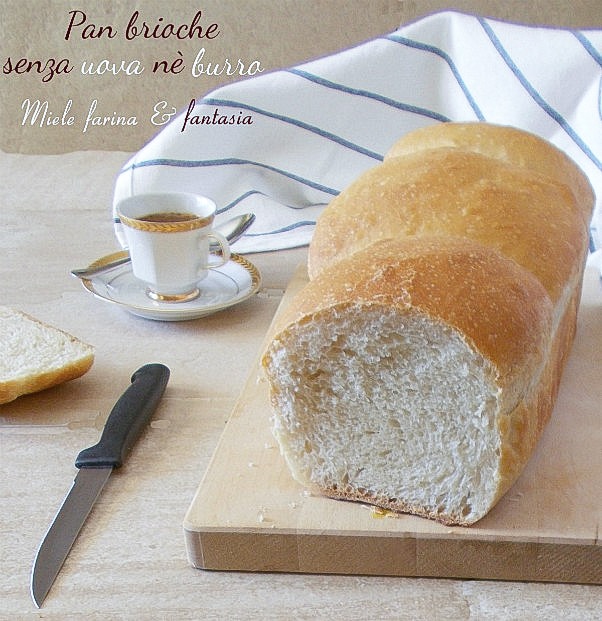Today I present my brioche bread, made without adding eggs, butter, or milk to the dough. Nevertheless, this easy and light leavened bread stays soft for several days and can be made for delicious appetizer sandwiches, for aperitifs, or to be enjoyed at breakfast or in your free time. It is one of those recipes I am very proud of, not out of presumption to which I am not accustomed, but because it is my creation. After much trial, I managed to find the right balance between the ingredients to obtain a fragrant product like brioche dough, soft yet well-structured, light and, unlike brioche dough, closer to bread in terms of texture and alveolar structure. Finally, the three leavenings are essential; they represent, in fact, the piece that contributes to making it so good and digestible.

- Difficulty: Very Easy
- Cost: Economical
- Rest time: 6 Hours
- Preparation time: 20 Minutes
- Portions: 20
- Cooking methods: Oven
- Cuisine: Italian
- Seasonality: All Seasons
Ingredients
- 0.11 oz fresh brewer's yeast
- 1 1/3 cups all-purpose flour
- 1/2 cup water at room temperature
- 2 3/4 cups all-purpose flour
- 2/3 cup water at room temperature
- 2 tsp fine salt
- 1 tsp wildflower honey (or powdered sugar)
- leavened pre-dough
- 1/4 cup light vegetable oil
Steps
First, let’s prepare the pre-dough (or sponge). Dissolve the fresh brewer’s yeast in a large bowl with the 1/2 cup of water. Then add the well sifted flour and mix until you get a soft dough like in photo 1 (a fork is enough). Cover the pre-dough bowl with plastic wrap and let it rise until it doubles, as shown in photo 2.
When the sponge has doubled its original volume, we can prepare the actual brioche bread dough.
In a mixing bowl, sift the 2 3/4 cups of all-purpose flour, add the salt, honey, half of the oil, and start mixing to combine the ingredients coarsely, as shown in photo 3. Don’t worry if you might need a little less or more water than I indicated, because flours don’t absorb liquids in the same way.
At this point, add the sponge dough (photo 4), the remaining oil, and knead until the two doughs are perfectly combined, photo 5. The dough is ready when it appears soft, smooth, and no longer sticks to your hands and the work table (or the bowl). Lightly oil the bowl where you will let it rise, seal well with plastic wrap, and wait for it to double, as shown in photo 6.
When the dough has risen well, let it fall gently onto the work table and, without deflating it, roll it towards you to form a loaf, a sort of cylinder (as in the last photo below). Finally, place the loaf vertically with respect to you and roll it again tightly.
These are precisely the steps that will give structure to the leavened bread, ensuring it rises well, is well alveolated, develops perfectly during baking, and does not collapse as soon as it comes out of the oven.
Line a mold with parchment paper.
Weigh the risen dough and divide it into three equal parts, which we will shape into spheres.
Place the three dough spheres in the mold, cover with plastic wrap, and let them rise for the third and final time..
As soon as the brioche bread reaches the upper edge of the mold, turn on the oven and bring it to 350°F.
Bake it in the preheated oven, at mid-height, for about 40 minutes, keeping an eye on it and remembering that temperatures and cooking times can vary from oven to oven.
Once cooked, remove it immediately from the oven and, after about ten minutes, take it out of the mold, remove the parchment paper, and place it on a wire rack to let the excess moisture evaporate without ruining the final result.
Let it cool for at least an hour before slicing.

